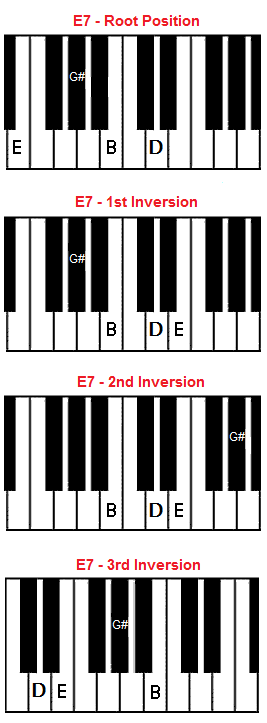How do you form an E7 chord on piano. Let’s learn all about it. First of all let’s take a look at the E major scale. This scale consists of the notes E, F#, G#, A, B, C#, D# and E. Since the 7 chord formula is 1 – 3 – 5 – 7b, the notes of the E seventh chord is E – G# – B – D. What we’ve done here is combine the root, major third, perfect fifth and flat seventh of the E major scale. Instead of playing the seventh note of the major scale (the note, C#), the note is played a semitone lower. So the note, C is played.
My Best Recommendation: Click here for the BEST piano/keyboard course I’ve seen on the Internet.
To form the chord, E7 on piano, first find the root note, E on the keyboard. Now count up 4 half tones from E to G#. To arrive at B, count up 3 half tones from G#. To arrive at D, count up three half tones from B. In terms of intervals, the chord is formed of a major interval followed by two minor intervals. So between E and G#, it’s a major interval. Between G# and B, it’s a minor interval, and between B and D it’s another minor interval.
Learn how to play piano chords with the Piano For All piano course.
E7 is also known as an E dominant seventh chord and is written E dom7, E7 and E dominant 7. E7 is comprised of four notes. It consists of a major triad plus a note forming a 7th interval above the root note of the chord.
In terms of chord progressions, every time E7 is played, the chord wants to move up a perfect 4th. The player gets the feeling that the next chord should be A. One doesn’t have to play A but this is the most likely chord to be played.
Inversions/voicings of the E7 chord on piano
Until now we’ve looked at the E7 chord only in its root position. As we’ve seen, in root position, the notes of the E7 chord are E – G# – B – D. What if we were to move the note, E an octave higher? This would give us the chord in its first inversion. In the 1st inversion, the notes of the E dominant seventh chord are in the sequence G# – B – D – E. In the second inversion, we move G# an octave higher and the sequence of notes is now B – D – E – G#. Lastly play the E seventh chord in its third inversion, move the note, B one octave higher to give you the sequence D – E – G# – B.
To learn how to form other chords on piano, return from E7 chord page to main piano chords page. You will learn how to form all kinds of piano chords including major, minor, 6th, 7th, diminished, augmented, and even 9th, 11th and 13th chords.
You can learn how to play piano with either Rocket Piano or Piano For All. Read my reviews on the best courses for learning how to play piano and keyboard here.
Free Beginner Piano Lessons: The Home Page